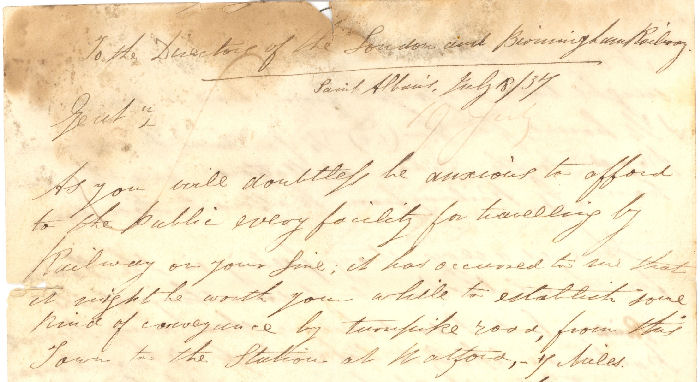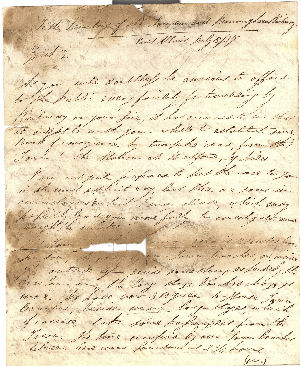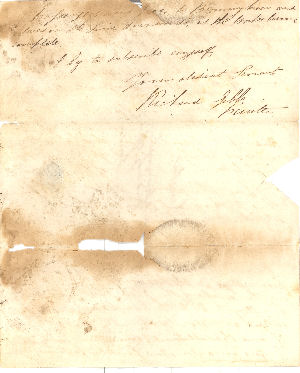|
Stage Coaches vs Railway, St Albans, 1837 and the coming of the Railway between St Albans and Watford |
|
Stage Coaches vs Railway, St Albans, 1837 and the coming of the Railway between St Albans and Watford |
Giulietta Pereira (giulietta.pereira @t gmail.com) has kindly given ,me an extremely interesting letter written in 1837 by Richard Gibbs of St Albans to the Directors of the London and Birmingham Railway. Because of the historical interest of the letter this page contains the following information:
1. The Letter, with Richard Gibbs' Seal, the post marks, and a transcription. This is a good example of a business letter of this period.
2. The little that is known about the history of this letter.
3, Gibbs family connections with St Albans
4. St Albans Stage Coaches before the Railway
5. The Opening of the London to Birmingham Railway
6. The impact of the Railway on St Albans, and the later line to Watford
7. A Comparison with Aylesbury, Bucks.
1. The Letter

|
To the Directors of the London & Birmingham Railway St Alban's July 18 1837 Gentlemen, As you will doubtless be anxious to afford to the public every facility for travelling by railway on your line it has occurred to me that it might be worth your while to establish some kind of conveyance by turnpike road from this Town to the station at Watford - 7 miles. I am quite prepared to put the case to you in the most explicit way, but there are some other circumstances to which I may allude which may probably lead you more fully to investigate and weigh the matter. This Town by the common road is 21 miles from London, the fares by our Town coaches are, inside 7/- outside 4/- beside something expected by the coachman, the long-stage coaches charge 1/- more. We have now 5 regular 4-horse Town coaches, beside many long-stages which of course take some passengers from the Town. The time occupied by our Town coaches between here and London is 2¾ hours. |
 |
|||||||
|
Now it strikes me that you as a Company might take passengers from hence to London in 1¾ hours for 3/- (i.e.) ¾ hour by common road to the station at Watford and ¾ hour by railway to London. There is a very strong feeling in the Town for the establishment of something of the kind, but I don't know that any private parties are likely to take it up. It would answer much better in the hands of the Company. I have thought it might not be improper thus to throw out these brief hints on the subject: if you should entertain any views of carrying them out I shall be happy to communicate with you on the matter. I beg to say in conclusion that I have a front shop in the premises which I occupy in the centre of the High Street which I should be willing to let to the Company, and to superintend as their Agent, as a Booking Office. Of course the establishment of some certain conveyance to Watford would also afford facilities for transmission --- |
 |
|||||||
| --- of Passengers and
Goods to Birmingham and places on the Line downwards as the works become complete·
|
 |
|||||||
|
|
|
|
||||||
|
||||||||
|
2. The Letter's History
The date stamps and seal on the letter show that it was written and posted on 18th July 1837 and presumably delivered to the London & Birmingham Railway Office in London. What happened to it over the next 100 years or so is a complete mysteery. In 2010 it was found by Giulietta in an envelope (prepaid printed first class) in an older envelope (posted 1954 to A. L. P. Carter, Brantham Place, Brantham, nr Manningtree, Essex), together with a transcript, in an old book, and was passed to me, as an interested relative.
The transcript was typed on a mechanical typewriter (possibly a small portable?) and its condition, etc, is compatible with it being of a similar age to the outer (1954) envelope. Both envelopes have writing describing the contents, the inner (newer) one has the words "Before the St Albans Branch was built. It is of interest to note that the L.M.S. Fare to London one hundred years later was about 2/6d return."
3. The Gibbs Family and the Shop
Richard Gibbs (1804-1883) was the youngest of four sons of Robert Gibbs (1768-1808) of Aylesbury. The family were non-conformist tradesmen and the family custom was to set their sons up in business shortly after they became 21. In 1824 John Gibbs (1792-1860, my great great grandfather), who was already established in business in Aylesbury, and his brother George Washington Gibbs (1802-1865) took the lease on a small shop at the base of the Clock Tower in St Albans. This was run as a pawnbroker and printer. It is known that the lease expired in 1829 and about this time George had moved to Liverpool, Richard Gibbs is known to have started working in the business in 1826 and when the lease expired continued the printing business from as yet unidentified premises in the High Street. He took the Old Moot Hall for his business on Dec. 14th, 1837. As he wrote the letter in July 1837 he may well have been anticipating the move to alternative, larger premises - and was looking to let the shop to the Railway Company for this reason. He later founded the newspaper the Herts Advertiser and his family played a significant part in the later history of St Albans.
Prior to the coming of the London to Birmingham Railway a significant part of the road traffic from London to the Midland and beyond passed through St Albans, as the extract from the 1828/29 Pigot's Directory shows. Stage Coaches and Carts from Luton to London: 1830 (and linked pages) provide a more detailed analysis of the traffic on the "minor" road north from St Albansto Luton, the majority of the traffic following the old Roman road to Dunstable.
The town was packed with inns and taverns catering for the passing trade (The Inns & Public Houses of St Albans in the 19th Century). With the coming of the turnpike roads the increases in traffic volume meant the roads in the town became heavily congested and the New London Road (bypassing Sopwell Lane and the steep Holywell Hill) and Verulam Road (bypassing Fishpool Street) were constructed to ease traffic movement.
The following part of the letter includes useful information on travel times and fares:
5. The Railway
The London and Birmingham Railway was the first railway out of London and work started in 1834. It opened between London and Boxmoor (now Hemel Hempstead Station), via Watford on 20th July, 1837 and the complete route to Birmingham was opened on 17th September 1838.
6. The Impact on St Albans
It would seem that the people of St Albans failed to anticipat the major impact the railway would have on the town. Richard Gibbs letter was sent only 2 days before the opening of the railway station at Watford - which does not suggest any great degree of forward thinking, and I am sure the Railway Company did not follow up his suggestion. However he was right in suggesting that people would find it quicker and more economical to travel as far as they could by train, and then complete the journey by horse-drawn coach. The "killer" was that the further one traveled by stage coach the bigger the advantage of rail - and few people who wanted to go to the Midlands, or further north and west would want to go by stage coach if they could get to places such as Rugby and Birmingham by train. The travel of goods by road (with the services needed for drivers and horses) would also be affected in a similar way.
What happened is illustrated by
Pigot's Home
Counties Directory for 1839 which reports "The inns, of which there are several
respectable ones, both posting and commercial, are supported in a
considerable degree by the influx of passengers; but their prosperity has
suffered a material diminution from the opening of the London and Birmingham
railway - one inn alone, it is said, having lost the stabling of two hundred
and fifty horses since this modern mode of conveyance has been brought into
operation."
In 1839 there were still a large number of coaches passing through St Albans but there was an additional service to Watford Station listed.
By March 1847 it was clear that St Albans needed to be on a railway line and a council meeting was "specially convened to consider the propriety of petitioning the House of Commons in favour of a Bill promoted by the London and North-Western Railway Company for powers to make a branch line from Watford to St. Albans, Luton, and Duustable. The seal of the Borough was affixed to the petition. A petition was also ordered to be presented in favour of a branch line from St. Albans to the main line, Great Northern Railway, at Hatfield, and thence to Hertford. The Borough members were to be requested to present the petitions and support the prayers thereof." [The Corporation Records of St Albans]
Progress towards getting a railway line was slow but at a council meeting in April 1859 "a letter was read from the London and North Western Railway Company stating that the opening of the branch line would take place on Wednesday, May 5th. It was decided the day should be a general holiday and that there should be a public dinner in the Town Hall, to which the Directors and others taking part in the ceremony should be invited as guests. A public subscription was to be raised to pay the cost of the same and to provide amusements for the humbler classes on so auspicious an occasion. A committee was appointed to confer with the railway officials as to train accommodation and fares." [The Corporation Records of St Albans]
On 5th May, 1859 the branch line was opened between Watford and St Albans. The Hatfield to St Albans branch line opened in 1865 and its first main line station, on the Midland Railway, did not open until 1868.
7. A Comparison with Aylesbury, Bucks
It is useful to compare what happened in St Albans, where initially people had failed to realise the possible impact of the railway, with what happened in Aylesbury, Buckinghamshire, where the Gibbs family were also involved. In The History of Aylesbury, Robert Gibbs (son of John Gibbs and nephew of Richard) wrote:
In view of his brother's interest in the Aylesbury branch line it is perhaps surprising that Richard did not take even more interest in the coming of the Railway. However the differnce between the two places was that Aylesbury, which was off the major routes north, saw the railway as an opportunity, while St Albans, which was already a very successful Stage Coach town did not see it as a threat. |
| August 2010 | Page created |